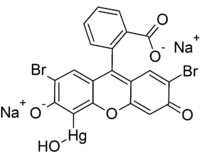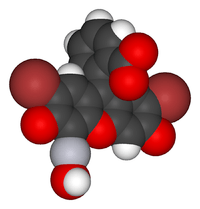Merbromin
 | |
 | |
 | |
| Names | |
|---|---|
| IUPAC name
dibromohydroxymercurifluorescein | |
| Identifiers | |
| 129-16-8 | |
| 3D model (Jmol) | Interactive image |
| ChEBI | CHEBI:6763 |
| ChEMBL | ChEMBL2097077 |
| ChemSpider | 10808965 |
| ECHA InfoCard | 100.004.486 |
| EC Number | 204-933-6 |
| KEGG | D00861 |
| UNII | M0T18YH28D |
| |
| |
| Properties | |
| C20H8Br2HgNa2O6 | |
| Molar mass | 750.66 g·mol−1 |
| Appearance | dark green solid |
| Pharmacology | |
| D08AK04 (WHO) | |
| Hazards | |
| Main hazards | Toxic, dangerous for the environment |
| R-phrases | R26 R27 R28 R33 R50 R53 |
| S-phrases | S13 S28 S36 S45 S60 S61 |
| Except where otherwise noted, data are given for materials in their standard state (at 25 °C [77 °F], 100 kPa). | |
| | |
| Infobox references | |
Merbromin (marketed as Mercurochrome, Merbromine, Sodium mercurescein, Asceptichrome, Supercrome, Brocasept and Cinfacromin) is a topical antiseptic used for minor cuts and scrapes. Merbromin is an organomercuric disodium salt compound and a fluorescein. It is readily available in most countries but, because of its mercury content, it is no longer sold in Switzerland, France, Germany, and the United States.[1][2][3]
Uses
Merbromin's best-known use is as a topical antiseptic to treat minor wounds, burns, and scratches.[4] It is also used in the antisepsis of the umbilical cord[5] and the antisepsis of wound of difficult scar formation, like neuropathic ulcers, and diabetic foot sores.[6] When applied on a wound, it stains the skin a distinctive carmine red, which can last up to 2 weeks through repeated washings. It is useful on infections of the finger or toe nails because of its permanence, and lethality to bacteria. It was known in many households as "monkey blood."[7]
The U.S. Food and Drug Administration in 1998 classified merbromin as "not Generally Recognized as Safe" together with a multitude of other active compounds, based on the absence of interest on the part of pharmaceutical companies in funding new studies or updated supporting information, due to the high costs of said studies in comparison to sales, rather than due to being toxic.[8]
In the United States, its use has been superseded by other agents (e.g., povidone iodine, benzalkonium chloride, chloroxylenol). It is still an important antiseptic, particularly in developing nations, due to its “unbelievably low cost.”[9]
Merbromin is also used as a biological dye to mark tissue margins and as a metal dye in industrial dye penetrant inspection to detect metal fractures.
Synthesis
Merbromin is synthesized by combining dibromofluorescein with mercuric acetate and sodium hydroxide or alternatively, through action of the mercuric acetate upon or (combining with) sodium dibromofluorescein. Because of its anionic character, it is chemically incompatible with acids, the majority of alkaloid salts and most local anesthetics.[10]
Mercurochrome
Mercurochrome is a trade name of merbromin. The name is also commonly used for over-the-counter antiseptic solutions consisting of merbromin (typically at 2% concentration) dissolved in either ethyl alcohol (tincture) or water (aqueous).
Its antiseptic qualities were discovered by Hugh H. Young in 1918, while working at Johns Hopkins Hospital as a physician.[11] The chemical soon became popular among parents and physicians for everyday antiseptic uses, and it was commonly used for minor injuries in the schoolyard.
The United States Food and Drug Administration (FDA) moved it from the “generally recognized as safe” classification into the “untested” classification to effectively halt its distribution in the United States on October 19, 1998 over fears of potential mercury poisoning.[1] Sales were halted in Germany in 2003,[2] and in France in 2006.[3] It is readily available in most other countries.
Within the United States, products such as Humco Mercuroclear play on the brand recognition history of Mercurochrome, but substitute other ingredients with similar properties (Mercuroclear: "Aqueous solution of benzalkonium chloride and lidocaine hydrochloride").[12]
The label on at least one brand of the compound listed the ingredients as "dibromoxymercuriflourescein sodium" and alcohol.
See also
- Thiomersal, also known as Thimerosal or Merthiolate
References
- 1 2 "Quantitative and Qualitative Analysis of Mercury Compounds in the List". Federal Food, Drug, and Cosmetic Act (FD&C Act). U.S. Food and Drug Administration. 2009-04-30.
- 1 2 de:Merbromin
- 1 2 fr:Merbromine
- ↑ "Prospecto autorizado Mercromina Film ®" (PDF). Retrieved 15 May 2013.
- ↑ Sellares Casas, E; et al. "Eficacia de una aplicación frente a 3 de merbromina en el tiempo de caída del cordón". Acta pediátrica Española. 60 (9). Check date values in:
|access-date=(help); - ↑ Gaitan Enríquez, J (September 1997). "Merbromina como tratamiento de elección en úlceras de pie diabético". Clínica rural. 497.
Se ha estudiado en 72 pacientes la eficacia de la merbromina comparativamente con la clorhexidina como antisépticos usados en la curación de múltiples afecciones en el pie diabético. Con el uso de merbromina se consigue disminuir apreciablemente el tiempo de cicatrización de las heridas, y se ha observado también una ausencia de complicaciones en los casos estudiados.
- ↑ http://www.retroist.com/2013/08/19/monkeys-blood-for-those-boo-boos/
- ↑ "Status of Certain Additional Over-the-Counter Drug Category II and III Active Ingredients".
- ↑ Mohite, P. N.; Bhatnagar, A. M. (2009). "Mercurochrome 1% as an Antiseptic for Burns: Economical - but is it Efficacious and Safe?". The Internet Journal of Surgery. 21 (2). ISSN 1528-8242.
Apart from these qualities, still the most important factor for which mercurochrome has remained the favorite of the physicians in the developing countries is its attractive price. The compound is being sold at unbelievably low cost ... the reasons being the low manufacturing cost, longer shelf life, use in diluted form and importantly less propaganda about its medical use.
- ↑ Budavary, Susan, ed. (1989). The Merck Index, An Encyclopedia of Chemicals, Drugs, and Biologicals (11 ed.). Rahway, New Jersey, USA.: Merck & Co. ISBN 091191028X.
- ↑ Wilner, I. (2006). The Man Time Forgot: A Tale of Genius, Betrayal, and the Creation of Time Magazine. Harper Collins. p. 230. ISBN 0-06-050549-4.
- ↑ "Mercuroclear MSDS" (pdf). Humco.